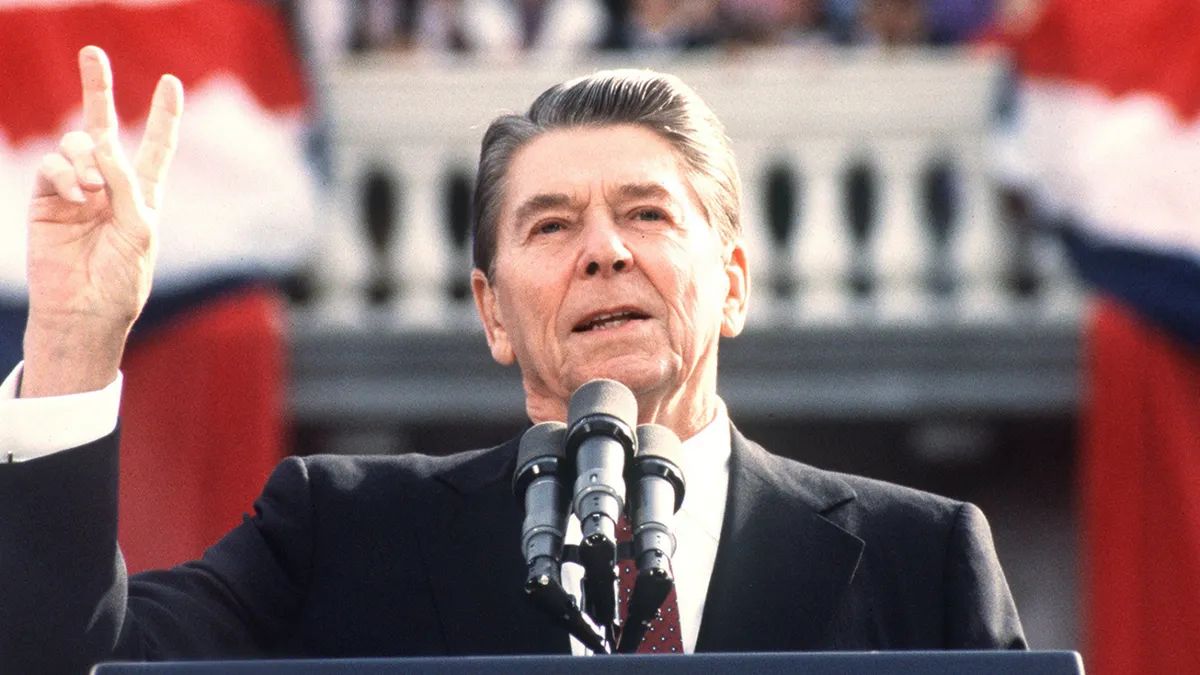Editor’s Note: This is a series of profiles taking a closer look at US presidents ahead of the 2024 presidential election between Donald Trump and Kamala Harris.
Ronald Reagan, the 40th President of the United States, is remembered for his transformative leadership, conservative revolution, and the pivotal role he played in ending the Cold War.
A former actor turned politician, Reagan’s two-term presidency (1981–1989) marked a shift in American politics, economics, and foreign policy. His charismatic persona and optimistic vision of America helped restore national confidence and left an enduring legacy that shaped the modern Republican Party.
Ronald Reagan on the big screen
Ronald Wilson Reagan was born on February 6, 1911, in Tampico, Illinois, to a working-class family. His early life was marked by modest circumstances. Reagan attended Eureka College, where he majored in economics and sociology, and developed an interest in acting and politics.
After college, he worked as a radio broadcaster before launching a successful Hollywood acting career, starring in more than 50 films.
During World War II, Reagan served in the US Army’s motion picture unit, making training films for the military.
His acting career and increasing involvement with the Screen Actors Guild led him to develop an interest in politics, initially as a Democrat but later shifting to the Republican Party in the 1960s.
A governorship to begin
Reagan’s conservative views became more prominent in the 1960s, particularly with his famous 1964 speech, “A Time for Choosing,” which gained him national attention.
In 1966, he was elected governor of California, serving two terms. His governorship was defined by efforts to reduce government spending and size, foreshadowing the policies he would later champion as president.
Reagan enters the White House
Reagan unsuccessfully ran for the Republican presidential nomination in 1976 but succeeded in 1980, defeating incumbent President Jimmy Carter.
Reagan campaigned on reducing government intervention in the economy, cutting taxes, and restoring American strength in the face of Soviet aggression. His landslide victory in 1980 made him, at 69, the oldest person elected president at the time.
The Reagan revolution
Reagan’s first term marked a dramatic shift in US policy, both domestically and internationally. Domestically, he implemented “Reaganomics”, an economic strategy centred on tax cuts, deregulation, and reductions in government spending, which aimed to stimulate growth by empowering private enterprise.
While inflation fell and the economy grew, critics argued that these policies exacerbated income inequality and ballooned the national debt.
Internationally, Reagan pursued an aggressive anti-Communist foreign policy, increasing defence spending and pushing back against the Soviet Union, which he famously called the “Evil Empire”.
His administration launched the Strategic Defense Initiative (SDI), a missile defence system that heightened tensions with the USSR.
Assassination attempt
On March 30, 1981, Reagan survived an assassination attempt by John Hinckley Jr outside a Washington, DC hotel.
Hinckley fired six shots, one of which struck Reagan in the chest, puncturing his lung. Despite the severity of the wound, Reagan recovered quickly, displaying humour and resilience that endeared him to the American public.
Reagan’s foreign policy amid a Cold War
Reagan’s foreign policy was characterised by a firm stance against communism and the Soviet Union. His military buildup and assertive rhetoric raised tensions in the early 1980s, but as Soviet leader Mikhail Gorbachev came to power, Reagan shifted to a more diplomatic approach.
This culminated in historic arms control agreements, including the Intermediate-Range Nuclear Forces (INF) Treaty of 1987, which significantly reduced nuclear arsenals.
Reagan’s ability to combine toughness with diplomacy is credited with helping to end the Cold War and dismantle the Soviet Union’s global influence. His rapport with Gorbachev was a key factor in easing tensions between the superpowers.
A scandalous second term
Reagan was re-elected in 1984 by a landslide, winning 49 of 50 states. His second term, however, was overshadowed by the Iran-Contra affair.
In 1986, it was revealed that Reagan administration officials had secretly sold arms to Iran, which was under an arms embargo, in exchange for hostages, and used the profits to fund the Contras in Nicaragua, despite a congressional ban. Although Reagan denied direct involvement, the scandal damaged his administration’s reputation.
Despite the controversy, Reagan remained popular, largely due to the continued economic recovery and his achievements in foreign policy. His second term also saw the signing of the INF Treaty and the beginning of the end of the Cold War.
Post-presidency and legacy
After leaving office in 1989, Reagan retired to California, where he lived with his wife, Nancy. In 1994, he announced that he had been diagnosed with Alzheimer’s disease, and he largely withdrew from public life until he died in 2004.
Reagan’s presidency is widely seen as transformative. His economic policies and emphasis on limited government redefined the Republican Party and set the tone for conservative politics for decades to come. Internationally, his role in ending the Cold War remains one of his most significant achievements. However, debates continue over the long-term effects of his domestic policies, particularly regarding income inequality and the national debt.
Ronald Reagan remains a towering figure in American politics, remembered for his communication skills, optimism, and unwavering belief in America’s potential. His ability to reshape the political landscape and restore national confidence is part of the enduring legacy of the “Great Communicator”.
With input from agencies


)

)
)
)
)
)
)
)
)



